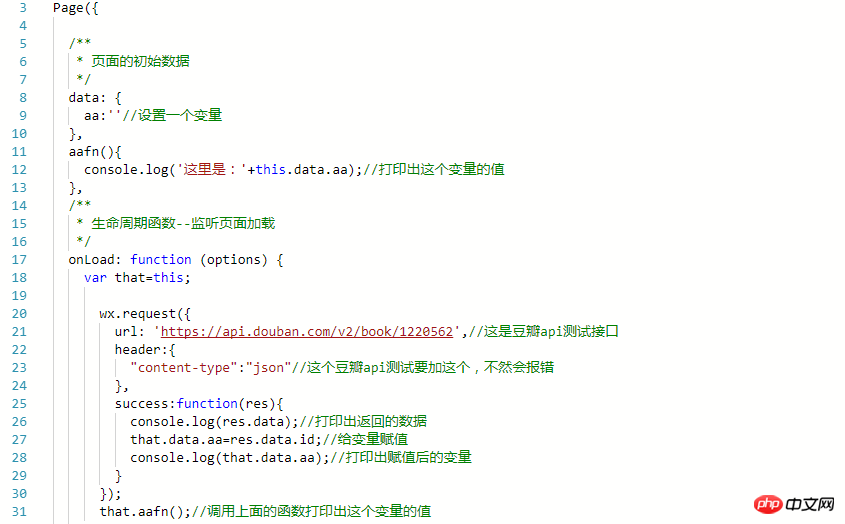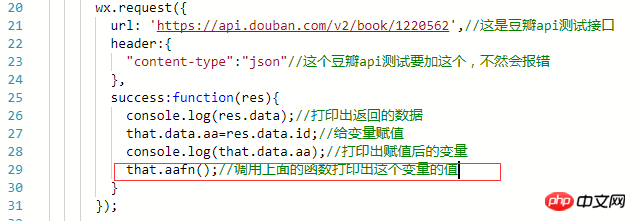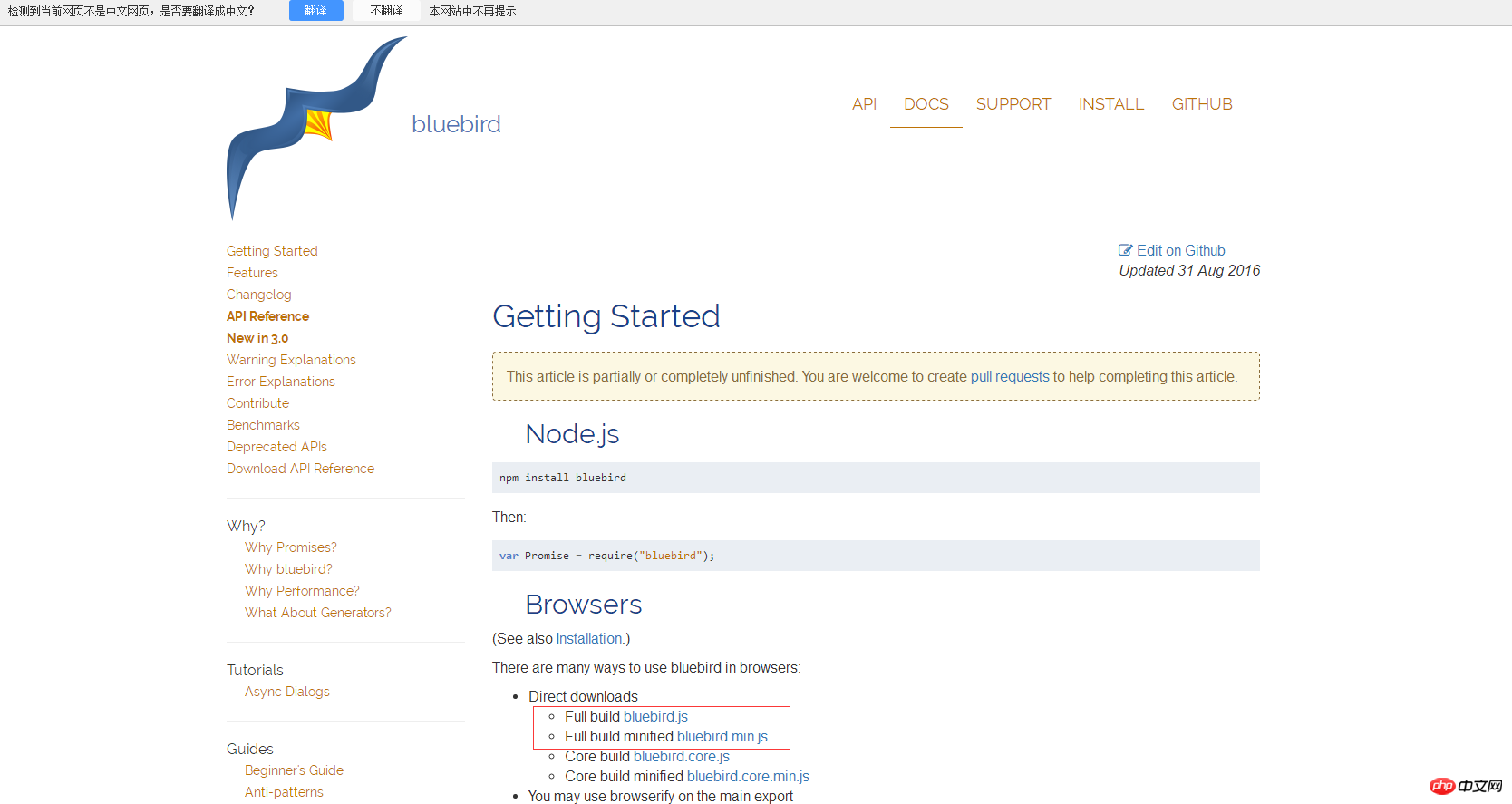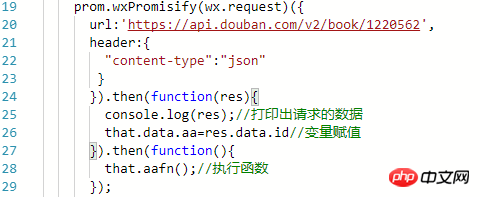About asynchronous processing of WeChat applet
This article mainly introduces the relevant information of asynchronous processing of WeChat mini programs in detail. It has certain reference value. Interested friends can refer to it.
The examples in this article share with you the WeChat mini programs. The specific method of asynchronous processing of the program is for your reference. The specific content is as follows
Look at the question directly:

Then look at the printed result:

As can be seen from the above two figures, the network request is executed first in the code, and then the printed variables are executed. However, from the results printed below, the one that outputs the result first is the one that executes the printed variables. function (aafn function), and then print out the data returned in the callback of the network request success and the value of the assigned variable;
Why is aafn executed first and the printed value is not assigned?
Because wx.request is an asynchronous request, the function can continue to be executed while data is being requested. So the value of the variable is printed before the value is assigned;
How to solve this situation?
Method 1:
Nesting
Execute the aafn function in the success callback of wx.request

Then run the result

The value is obtained here
But if the logic is very complicated, You need to use many layers of asynchronous, like this:
asyncFn1(function(){
//...
asyncFn2(function(){
//...
asyncFn3(function(){
//...
asyncFn4(function(){
//...
asyncFn5(function(){
//...
});
});
});
});
});This way the code looks very ugly, and the readability and maintainability of the code are not good. Okay
How to solve this problem? The emergence of the concept of Promise solves all this well. What is Promise? I won’t say much here. If you are interested, take a look for yourself. Promise introduction link
Let’s take a look at the way of Promise:
function asyncFn1(){
return new Promise(function (resolve, reject) {
//...
})
}
// asyncFn2,3,4,5也实现成跟asyncFn1一样的方式...Call
asyncFn1() .then(asyncFn2) .then(asyncFn3) .then(asyncFn4) .then(asyncFn5);
In this case, the asynchronous functions can be executed sequentially
How does the asynchronous API of the WeChat applet support Promise? We can use Promise to wrap these APIs one by one, but this is still troublesome. However, the parameter format of the API of the mini program is relatively uniform. It only accepts one object parameter, and the callbacks are set in this parameter. Therefore, this provides convenience for unified processing. Write a tool method to complete such work
First you need to reference a file called bluebird.js;
Enter bluebird official website to download:

It seems that this cannot be downloaded, but you can click to enter, then copy, create a js file in the mini program, copy the code into the js, and then quote it.
Then write a JS and write the tool methods in it:

The following is prom.js

Then introduce prom.js into the js of the page you need to use:

Call:

Print results

That’s it, it’s over.
The above is the entire content of this article. I hope it will be helpful to everyone's study. For more related content, please pay attention to the PHP Chinese website!
Related recommendations:
##WeChat Introduction to the life cycle of the mini program page and audio playback and monitoring
The above is the detailed content of About asynchronous processing of WeChat applet. For more information, please follow other related articles on the PHP Chinese website!

Hot AI Tools

Undresser.AI Undress
AI-powered app for creating realistic nude photos

AI Clothes Remover
Online AI tool for removing clothes from photos.

Undress AI Tool
Undress images for free

Clothoff.io
AI clothes remover

Video Face Swap
Swap faces in any video effortlessly with our completely free AI face swap tool!

Hot Article

Hot Tools

Notepad++7.3.1
Easy-to-use and free code editor

SublimeText3 Chinese version
Chinese version, very easy to use

Zend Studio 13.0.1
Powerful PHP integrated development environment

Dreamweaver CS6
Visual web development tools

SublimeText3 Mac version
God-level code editing software (SublimeText3)

Hot Topics
 1654
1654
 14
14
 1413
1413
 52
52
 1306
1306
 25
25
 1252
1252
 29
29
 1225
1225
 24
24
 Xianyu WeChat mini program officially launched
Feb 10, 2024 pm 10:39 PM
Xianyu WeChat mini program officially launched
Feb 10, 2024 pm 10:39 PM
Xianyu's official WeChat mini program has quietly been launched. In the mini program, you can post private messages to communicate with buyers/sellers, view personal information and orders, search for items, etc. If you are curious about what the Xianyu WeChat mini program is called, take a look now. What is the name of the Xianyu WeChat applet? Answer: Xianyu, idle transactions, second-hand sales, valuations and recycling. 1. In the mini program, you can post idle messages, communicate with buyers/sellers via private messages, view personal information and orders, search for specified items, etc.; 2. On the mini program page, there are homepage, nearby, post idle, messages, and mine. 5 functions; 3. If you want to use it, you must activate WeChat payment before you can purchase it;
 WeChat applet implements image upload function
Nov 21, 2023 am 09:08 AM
WeChat applet implements image upload function
Nov 21, 2023 am 09:08 AM
WeChat applet implements picture upload function With the development of mobile Internet, WeChat applet has become an indispensable part of people's lives. WeChat mini programs not only provide a wealth of application scenarios, but also support developer-defined functions, including image upload functions. This article will introduce how to implement the image upload function in the WeChat applet and provide specific code examples. 1. Preparatory work Before starting to write code, we need to download and install the WeChat developer tools and register as a WeChat developer. At the same time, you also need to understand WeChat
 Implement image filter effects in WeChat mini programs
Nov 21, 2023 pm 06:22 PM
Implement image filter effects in WeChat mini programs
Nov 21, 2023 pm 06:22 PM
Implementing picture filter effects in WeChat mini programs With the popularity of social media applications, people are increasingly fond of applying filter effects to photos to enhance the artistic effect and attractiveness of the photos. Picture filter effects can also be implemented in WeChat mini programs, providing users with more interesting and creative photo editing functions. This article will introduce how to implement image filter effects in WeChat mini programs and provide specific code examples. First, we need to use the canvas component in the WeChat applet to load and edit images. The canvas component can be used on the page
 Implement the drop-down menu effect in WeChat applet
Nov 21, 2023 pm 03:03 PM
Implement the drop-down menu effect in WeChat applet
Nov 21, 2023 pm 03:03 PM
To implement the drop-down menu effect in WeChat Mini Programs, specific code examples are required. With the popularity of mobile Internet, WeChat Mini Programs have become an important part of Internet development, and more and more people have begun to pay attention to and use WeChat Mini Programs. The development of WeChat mini programs is simpler and faster than traditional APP development, but it also requires mastering certain development skills. In the development of WeChat mini programs, drop-down menus are a common UI component, achieving a better user experience. This article will introduce in detail how to implement the drop-down menu effect in the WeChat applet and provide practical
 How to debug asynchronous processing issues in PHP functions?
Apr 17, 2024 pm 12:30 PM
How to debug asynchronous processing issues in PHP functions?
Apr 17, 2024 pm 12:30 PM
How to debug async processing issues in PHP functions? Use Xdebug to set breakpoints and inspect stack traces, looking for calls related to coroutines or ReactPHP components. Enable ReactPHP debug information and view additional log information, including exceptions and stack traces.
 What is the name of Xianyu WeChat applet?
Feb 27, 2024 pm 01:11 PM
What is the name of Xianyu WeChat applet?
Feb 27, 2024 pm 01:11 PM
The official WeChat mini program of Xianyu has been quietly launched. It provides users with a convenient platform that allows you to easily publish and trade idle items. In the mini program, you can communicate with buyers or sellers via private messages, view personal information and orders, and search for the items you want. So what exactly is Xianyu called in the WeChat mini program? This tutorial guide will introduce it to you in detail. Users who want to know, please follow this article and continue reading! What is the name of the Xianyu WeChat applet? Answer: Xianyu, idle transactions, second-hand sales, valuations and recycling. 1. In the mini program, you can post idle messages, communicate with buyers/sellers via private messages, view personal information and orders, search for specified items, etc.; 2. On the mini program page, there are homepage, nearby, post idle, messages, and mine. 5 functions; 3.
 Use WeChat applet to achieve carousel switching effect
Nov 21, 2023 pm 05:59 PM
Use WeChat applet to achieve carousel switching effect
Nov 21, 2023 pm 05:59 PM
Use the WeChat applet to achieve the carousel switching effect. The WeChat applet is a lightweight application that is simple and efficient to develop and use. In WeChat mini programs, it is a common requirement to achieve carousel switching effects. This article will introduce how to use the WeChat applet to achieve the carousel switching effect, and give specific code examples. First, add a carousel component to the page file of the WeChat applet. For example, you can use the <swiper> tag to achieve the switching effect of the carousel. In this component, you can pass b
 Implement the sliding delete function in WeChat mini program
Nov 21, 2023 pm 06:22 PM
Implement the sliding delete function in WeChat mini program
Nov 21, 2023 pm 06:22 PM
Implementing the sliding delete function in WeChat mini programs requires specific code examples. With the popularity of WeChat mini programs, developers often encounter problems in implementing some common functions during the development process. Among them, the sliding delete function is a common and commonly used functional requirement. This article will introduce in detail how to implement the sliding delete function in the WeChat applet and give specific code examples. 1. Requirements analysis In the WeChat mini program, the implementation of the sliding deletion function involves the following points: List display: To display a list that can be slid and deleted, each list item needs to include




